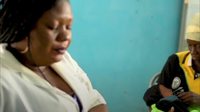Digital revolution in diagnostics for young childrenImpact evaluation of a Swiss health project in Burkina Faso
An
impact evaluation co-financed by the SDC confirmed the positive impact of the
project on Burkina Faso's health system.
This in turn aroused international interest and mobilised new partners and donors for the project.
For example, the World Health Organization (WHO) is working today to extend the Integrated e-Diagnostic Approach (IeDA) into neighbouring Mali and Niger.
This in turn aroused international interest and mobilised new partners and donors for the project.
For example, the World Health Organization (WHO) is working today to extend the Integrated e-Diagnostic Approach (IeDA) into neighbouring Mali and Niger.
Burkina Faso
With
80% of its population living in rural areas, providing high-quality healthcare
across Burkina Faso poses a major challenge:
in 2013, one in every eight children died owing to misdiagnosis or incorrect medication.
in 2013, one in every eight children died owing to misdiagnosis or incorrect medication.
In 1999, UNICEF and the WHO developed clinical
guidelines for the diagnosis of childhood diseases (Integrated Management of
Childhood Illness, IMCI). These guidelines were also introduced in Burkina
Faso in 2003.
However, the training of healthcare workers to apply the IMCI standards was inadequate. Even with the correct diagnosis, inappropriate medication was often prescribed.
However, the training of healthcare workers to apply the IMCI standards was inadequate. Even with the correct diagnosis, inappropriate medication was often prescribed.
IeDA project
In 2013, Terre des hommes
and the Ministry of Health in Burkina Faso launched the Integrated e-Diagnosis
Approach (IeDA) project.
It helps health workers to comply more strictly with the clinical protocol of the IMCI guidelines.
At the heart of the project is a tablet app that helps with diagnosis and treatment and at the same time registers the patient data of young children.
It helps health workers to comply more strictly with the clinical protocol of the IMCI guidelines.
At the heart of the project is a tablet app that helps with diagnosis and treatment and at the same time registers the patient data of young children.
The
project has four main strands:
e-diagnostics: to improve diagnosis and treatment and reduce paperwork.
data analysis: to increase data quality and security. Common mistakes are identified and are noticed more quickly.
e-learning: to reduce training costs and reliance on individual training.
quality assurance and coaching: to improve general health services, individual performances of the personnel are recorded and can be further developed as required.
e-diagnostics: to improve diagnosis and treatment and reduce paperwork.
data analysis: to increase data quality and security. Common mistakes are identified and are noticed more quickly.
e-learning: to reduce training costs and reliance on individual training.
quality assurance and coaching: to improve general health services, individual performances of the personnel are recorded and can be further developed as required.
Impact evaluation
From
2014 to 2017, an impact evaluation was carried out alongside the implementation
of the project in eight regions of the country.
The evaluation demonstrated the positive impact of the project on the diagnosis and treatment of under-fives and general compliance with IMCI standards.
The evaluation demonstrated the positive impact of the project on the diagnosis and treatment of under-fives and general compliance with IMCI standards.
Methodology
For
three years, data was collected from health centres in the regions where the
IeDA approach was gradually introduced.
In all, the examination and diagnosis of 2,038 young children were recorded.
In 695 cases (target group) the new software was used, while in 1,343 cases (control group) the diagnosis was carried out on printed forms.
In all, the examination and diagnosis of 2,038 young children were recorded.
In 695 cases (target group) the new software was used, while in 1,343 cases (control group) the diagnosis was carried out on printed forms.
Results
Compared
with the control group, in the target group, where the software was used, compliance with
the IMCI guidelines was 25% better.
For all types of diagnosis, the proportion of correct diagnoses was significantly better. In the diagnosis of infectious diarrhoea (dysenterie) in particular, successful diagnosis was 39% higher.
The unnecessary prescription of antibiotics could thus be reduced by 6–15%.
For all types of diagnosis, the proportion of correct diagnoses was significantly better. In the diagnosis of infectious diarrhoea (dysenterie) in particular, successful diagnosis was 39% higher.
The unnecessary prescription of antibiotics could thus be reduced by 6–15%.
Terre des hommes and the Ministry of Health of Burkina Faso have
since been involved in the further financing and expansion of the IeDA
approach.
Since its launch, the IeDA system has been used in over 4 million consultations in Burkina Faso, with more than 2.2 million patients under the age of five registered and diagnosed.
Since its launch, the IeDA system has been used in over 4 million consultations in Burkina Faso, with more than 2.2 million patients under the age of five registered and diagnosed.
The
aim is that by 2020, 62% of all health centres in the country will be working
with the new software and over 3 million patients will be registered.
The positive results of the impact evaluation have aroused international interest. New financiers, most notably the Bill & Melinda Gates Foundation, and partners are now implementing the project in other regions of the world.
Further information about IeDA:
Terre des hommes
The positive results of the impact evaluation have aroused international interest. New financiers, most notably the Bill & Melinda Gates Foundation, and partners are now implementing the project in other regions of the world.
Further information about IeDA:
Terre des hommes
Scroll down to continue
Swipe to continue
Swipe to continue























 Digital revolution in diagnostics for young children
Digital revolution in diagnostics for young children

 Burkina Faso
Burkina Faso

 IeDA project
IeDA project

 Impact evaluation
Impact evaluation
 Methodology
Methodology
 Results
Results

